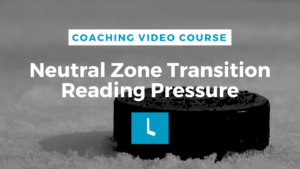(Transcribed from How to Play Hockey: Our Minor Hockey Coaching Course.)
The ‘reverse breakout’. Again it’s a bit of a combination between the ‘wheel’ and the ‘quick up’ and even at times the ‘three quarter round’ is tossed in. A reverse should generally be called by D2 which is the weak side defenseman or the D without the puck. Because if D1 reverses it and D2 is not there to get it can cause some major trouble. If a W calls the reverse and D2 isn’t ready for it, again it can cause some trouble.
[maxbutton id=”2″ ]
Example:
- D1 has the puck and is wheeling behind the net
- D2 has his/her feet up ice scanning the play, being vocal to D1 and knows that there is forechecking pressure coming, either from across net front or from the weak side, and knows that this area from which the D1 is just coming, is going to open up.
- D2 then calls a reverse and the D1 puts it off the boards into the soft area from which they came and the D2 peels off and gets it and away we go with the rest of our standard options. –
- As mentioned in the three quarter round our C in mirroring the play with patience and timing.-
- Our strong side W is reading it as a wheel, but once the puck is reversed they open up to be that strong side quick up outlet on the wall.-
- Weak side W is being patient reading the play and reacting making sure to either be that main outlet if it is a wheel play. Once it becomes the reverse then getting his/her feet moving being a secondary option for the breakout.
So it’s really important again that our D1 sells the wheel. We like to say you have to ‘sell’ the wheel, to sell it means…make sure that everyone in the whole arena thinks you’re going to skate behind the entire net to the weak side… it pulls the forecheckers across, then you can chip it off the boards and keep your head up.
If you’re playing or coaching hockey that allows hitting, once the forechecker finishes his/her check, the D1 can’t just stand still and watch the pass. Once this D2 has come down and taken this reverse it’s going to be your role to switch as we’ve described and get to the front of the net area in a defensive position.
That is the reverse breakout, when done well it is very effective!
We’ll see you in the next video!
Looking to download half ice hockey practice plans, goalie drills for teams (not a goalie coach?!) or small area games drills? We’ve got you covered too. Click here. Perfect for recreational level coaches.





